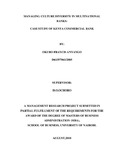| dc.description.abstract | Globalization of business and unprecedented movement of labor across borders have created organizations that comprise a mixture of people from many different cultures. Managing an organization with a multicultural workforce creates challenges in terms of management practices and leadership style, due to the differing viewpoints it elicits. Overall benefits and problems of a culturally heterogeneous organization can be closely related to how effective it is managed. This is one of the reasons why cultural heterogeneity is a pressing managerial issue and therefore given much attention in recent research. The purpose of this Study was to establish how to manage cultural diversity in Multinational Banks.
To reach this purpose the researcher investigated the benefits and the problems of a culturally diverse organization as well as the effective management practices and the leadership qualities necessary for managing a culturally diverse organization. Empirical data collected are based on Questionnaires administered to senior managers of Kenya Commercial Bank. A response rate of 83% was achieved out of the targeted respondents.
Findings of this study demonstrate that a multicultural organization can suffer from problems such as stereotyping and prejudicing, difficulty of communicating and predicting behavior. Nonetheless, the main result of the study showed that the benefits of being a culturally diverse organization clearly cancel out the problems. More specifically, these types of organizations have the opportunity to benefit from, for instance, an enhanced problem-solving capacity, enhanced effectiveness and efficiency, increased client satisfaction, and increased profits.
Most importantly, having a culturally heterogeneous workforce can be seen upon as a competitive advantage. The study also indicates that certain management practices can to a great extent resolve some of the problems related to cultural diversity. As an example, culturally diverse organizations can try to raise employees' consciousness and awareness about differences that exist across cultures and subgroups, in order to address stereotypical attitudes and VIews.
Furthermore, organizations develop communication competency to avoid misunderstandings and put effort on turning diversity visions into reality in order to keep the trust of involved parties. The final findings of this study reveal that certain leadership qualities are necessary in order to manage a culturally diverse workforce: these are empathy, commitment, tangible engagement, honesty, and being a 'people-lover'. | en_US |

